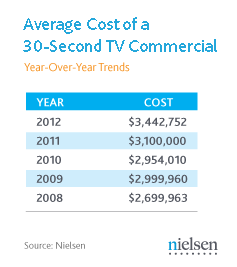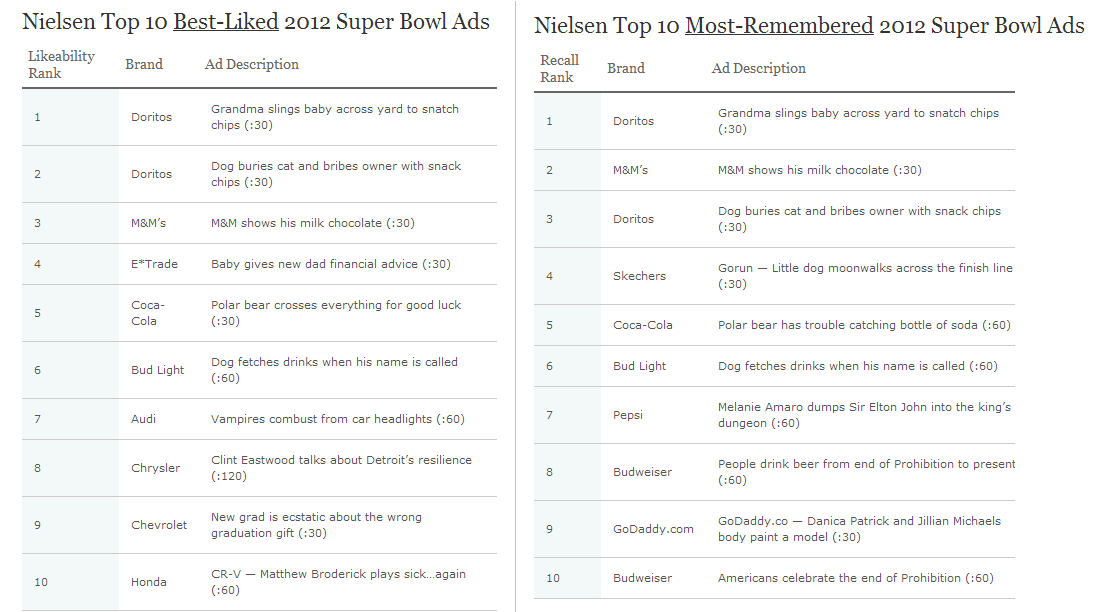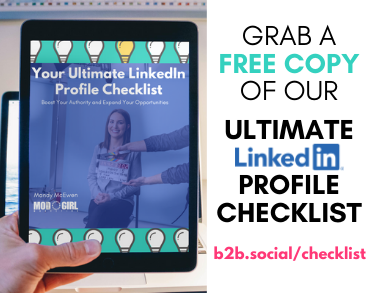The Super Bowl is the most highly anticipated advertising event of the year. Even if you don’t have the budget for a multi-million-dollar TV spot, your business can still learn a lot from what advertisers are doing during this high-profile event.

Lesson 1: Exposure Is Expensive!
Super Bowl 2012 attracted a whopping 111.3 million viewers, making it the “most-watched telecast of all time.” WOW! To have your product and your brand in front of that many people is going to cost you, though. Nielsen reports that the cost for a 30-second TV spot is creeping up toward $3.5 million.
Lesson 2: Sometimes It’s Worth The Splurge.
It’s not practical for small companies to take out a loan just to run a Super Bowl ad. However, for companies that gross millions or billions a year, the splurge on a well-thought ad could be worthwhile. Nielsen data suggests that ads running during last year’s Super Bowl were 34 percent more memorable and 42 percent better-liked than commercials airing one month prior. According to an Infographic by SaveOnBrew.com, 58 percent of Super Bowl viewers go to the bathroom during the game so they won’t miss the commercials!
Lesson 3: Know Thy Market.
Deciding to run a Super Bowl ad requires quite a bit of soul-searching — or at least it should. One year after advertising in the 2000 Supr Bowl, 42 percent of dot.com companies declared bankruptcy, according to Brad Adgate, research director at Horizon Media. This year, ailing electronics retailer Best Buy will take a gamble with an ad starring Amy Poehler. This will be the company’s third consecutive year of Super Bowl face-time, but it might be difficult to persuade people to abandon Amazon in 30 seconds. A similar conundrum exists for Research In Motion (RIM), which hopes to convince users that the problems-riddled Blackberry is better than the iPhone.
Lesson 4: Consider A Test-Drive.
Nearly a third of Super Bowl advertisers are debuting commercials during the game for the first time, according to Kantar Media. In 2011, 31 percent of these companies spent over 10 percent of their annual advertising budget on a single ad. For some companies, the decision paid off. Take, for example, E-Trade online brokerage firm. After their adorable baby Super Bowl ad in 2008, the company saw a hefty 32 percent increase in new accounts the following week! At the time, the company was hurting financially and had just suffered an 80 percent drop in stock that year. Job search site CareerBuilder.com saw a 40 percent year-over-year growth in invoices and 23 percent increase in job applications in the month following their Super Bowl ad.
Lesson 5: Generate Buzz Early.
In recent years, we’ve seen companies release their Super Bowl ads online early. According to Nielsen, the ten “most-remembered” and “best-liked” ads came from brands that “were able to generate a large share of Super Bowl advertising buzz before and during the game.” Pepsi, Coca-Cola, M&Ms and Doritos were among the companies that got people excited in 2012. This year, everyone is talking about the Kate Upton Mercedes ad, Budweiser ads featuring their newest Clydesdale and their newest beers, Taco Bell’s “Viva Young” ad, and the winner of Doritos’ 7th annual “Crash the Super Bowl” competition.
Lesson 6: People Love Animals, Babies & Celebrities.
If you look at the Top 10 “Most Remembered and Loved” Super Bowl ads of all-time, you’ll notice a few similar themes. The vast majority of ads contained some sort of animal, baby, or celebrity. Dogs buried cats, fetched beer, and moonwalked. Babies flew in slings across the yard and gave financial advice. Elton John, Matthew Broderick, Danica Patrick and Clint Eastwood all made celebrity guest appearances in 2012.
Lesson 7: Be Prepared.
Websites that aren’t used to a ton of traffic will need to be reinforced before the influx of new visitors occurs — which could quite possibly shut down a site. It may be necessary to move to a dedicated server with a ton of space. The Super Bowl will cause a 20 percent spike in traffic during and in the 7 days following the game, according to the Adobe Digital Index. Many people will be viewing your site on mobile phones and tablets this year, so advertisers must be fully optimized for these alternate devices.
Lesson 8: Find Ways To Engage.
This year, Coca-Cola is running a CokeChase.com campaign to appeal to mobile users during the game. Lincoln is planning a commercial that features real-life tweets from their customers. Pizza Hut asked for football fans to submit videos of themselves chanting, “Hut! Hut! Hut!” Toyota asked users to submit photos of themselves with the hashtag #wishgranted for their ad. Doritos let fans create their own commercials for a chance to have their work featured in their annual Super Bowl slot. USA Today explains, “Advertisers are trying to coax customers into getting more involved with their brands.” People who are emotionally attached to a brand are more willing to watch the entire ad, talk about the ad, and subsequently buy from the brand.
Looking for more advertising tips? Get my FREE report here!
[sharebox4 sharetext=”Share This Page”] [/sharebox4]




